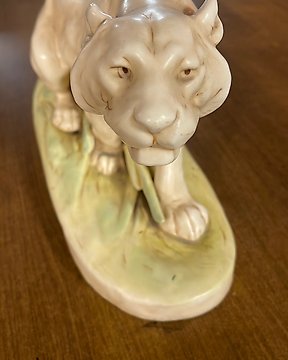
Royal Dux Porzellan-Manufaktur - Otto Jarl - Figurka - Porcelana
Nr 83693785

Nr 83693785

A Large Royal Dux Porcelain figurine, 18 Inches (45.7 cm) high.
The famous Pink Triangle.
Royal Dux introduced one of the most distinctive marks ever placed on porcelain, a raised triangle of pink clay. All factory-applied pink triangles–whether from the 19th, 20th or 21st century–are made from a separate piece of pink clay. The pink clay is applied to the base of Royal Dux white clay bodies. The two separate pieces are fused together during firing. There is virtually never the slightest seam or gap between the pink clay of the triangle and the white clay of the piece to which the triangle is applied.
Before WW I, pink triangles were generally, but not always, left in a bisque, or unglazed, finish. Most Art Nouveau figures in matte glaze, for example, usually have bisque triangles. After WW I, Art Deco figures entirely glazed in a high gloss occasionally have glazed triangles. Pieces with gloss glazes after 1950, especially after 1980 are more likely to have some glaze on the triangle. Although bisque triangles are the general rule, there is considerable variation over the years.
Factory triangles are all roughly the same size, about one-half inch per side and raised about one-sixteenth inch thick, rarely more than one-eighth inch thick. Size varies slightly because some original triangles were slightly deformed when damp.
Appearing in all genuine factory-applied raised pink triangles, regardless of age, is "Royal Dux Bohemia." That lettering appears around an oval shape in the center of the triangle. A crosshatch, or grid-like pattern, is at the top of the oval. Even though the country of Bohemia disappeared at the end of WW I, Royal Dux Bohemia remains in the mark to this day.
All factory-applied pink triangles, new or old, are generally very high quality. You almost never find a blurred, indistinct or illegible impressions in factory-applied triangles. Virtually all factory-applied triangles have sharp, clear lettering impressed to an equal depth.
E Impressed Triangle, ca. 1860-WW I
Each of the four periods of production can be roughly identified by changes in marks. In the first period, 1860 to WW I, the letter E is impressed in the center of the pink triangle. E represents Eichler, the founder's surname (see line drawing and photo in Figs. 2-3). The letter in the center of triangles changes over the years. It's important to keep in mind that E is the earliest. A convenient way to remember this is by word association: E is for early. The great majority of authentic factory-applied triangles from the first production period are unglazed.
Additional marks from the first period of production include Figs. 4-5-6 which are usually impressed. Any of the marks from the first production period in Figs. 2-6 may appear alone or in various combinations with any other mark.
Made in Czechoslovakia, ca. 1919
Following the end of WW I, Bohemia, the home of Royal Dux, was united with Slovakia and Moravia to form a new nation, Czechoslovakia. This change was reflected in the phrase "Made in Czechoslovakia" which appeared in Royal Dux marks around 1919 (Figs. 7-9). The letter E continued to be impressed in the center of the pink triangle and "Royal Dux Bohemia" impressed around the oval.
Made in Czechoslovakia can appear joined to other Royal Dux marks or can appear separately at a distance from other marks. Typical colors for stamped ink marks include green and a reddish-pink.
D Impressed in Triangle, ca. 1947
At the end of WW II, Russia, then the Soviet Union, continued to occupy east-European countries its troops held when Germany surrendered. This included Czechoslovakia. Russia nationalized almost all Czechoslovakian industries including Royal Dux. Around 1946-47, the factory was renamed Duchcovsky Porcelain after the regional name of Duchov.
The letter E is removed from the center of the pink triangle at this time and replaced by the letter D. Royal Dux Bohemia continues to appear around the oval. The triangle is still a separate piece of pink clay applied to a white clay body. Made in Czechoslovakia again appears in marks sometime in the early 1950s.
Some products made in the early 1950s have an M rather than a D in the pink triangle. Very few of these pieces have been seen in western markets. For all practical purposes, the letter D is the dominant letter in the vast majority of pink triangles since WW II.
Jak kupować w serwisie Catawiki
1. Odkryj coś wyjątkowego
2. Złóż najwyższą ofertę
3. Dokonaj bezpiecznej płatności